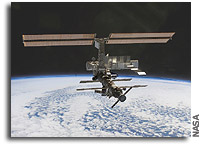Upcoming Space Shuttle Mission to Deliver Third Large Space Station Truss Segment
 Next week, Space Shuttle Endeavour will deliver to the International Space
Next week, Space Shuttle Endeavour will deliver to the International Space
Station (ISS) the third piece of the Station’s exterior truss backbone, and
kick off the third year of science inside the orbiting laboratory by
bringing up a new load of scientific experiments.
The 14-ton, girder-like, Port One, or P1 truss — assembled and tested at
NASA’s Marshall Space Flight Center in Huntsville, Ala. — will enhance the
Station’s future cooling and power systems. It will be attached to the left
side of the Segment Zero, or S0 truss, during the fourth day of the STS-113
mission.
While the Endeavour is docked with the Station, astronauts will perform
three spacewalks to outfit and activate the new truss. The Station’s other
two truss structures – the S0 and Starboard One, or S1 — were installed
earlier this year.
“This is the first port integrated truss segment to be delivered to the
Station,” said Alex Pest, the Boeing Company manager who oversaw the
completion of the P-1 truss when it was assembled and tested at the Marshall
Center. “We tested the truss’ strength, as well as its electrical
connections and fluid lines that will be important for future Station power
and cooling.”
The STS-113 mission also kicks off the beginning of the third year of
science aboard the orbiting research laboratory and marks the start of a new
four-month crew rotation on the ISS. Expedition Six Commander Ken Bowersox
and NASA ISS Science Officer Don Pettit and Flight Engineer Nikolai Budarin
will conduct new scientific experiments and continue research started on the
five prior expeditions.
Although the Station is in the process of being built and the lab is still
being outfitted, research hours are adding up. More than 65 NASA-funded
investigations have compiled more than 90,000 hours of science operations
time on-orbit. The Station’s five Expedition crews have devoted more than
1,000 hours to research on the ISS.
To carry out Expedition Six’s 19 experiments, the crew will work closely
with ground controllers in the science command post for ISS science
operations – the Payload Operations Center at Marshall.
“We manage all the science operations on the Station and work with planners
and scientists around the world to schedule research activities,” said Lamar
Stacy, the payload operations director who leads the Expedition Six payload
ops team at the Marshall Center. “To ensure successful operations, we work
before each expedition, training the crew and preparing procedures for
conducting research in orbit.”
Many of the Station experiments are managed by the Marshall Center.
Fundamental experiments that explore how physical processes are affected by
the microgravity, or low-gravity inside the Station, are managed by
Marshall’s Microgravity Sciences and Applications Division. Industry-funded
research conducted through NASA’s 15 Commercial Space Centers is managed by
the Space Product Development Program at the Marshall Center.
The new investigations include two series of fluid physics experiments to be
conducted inside the Microgravity Science Glovebox – a major research
facility delivered to the Station in June. The glovebox features a sealed
work area with windows and attached rubber gloves that allow crewmembers to
work safely with experiments involving chemicals, fluids and burning or
molten samples. It was built by the European Space Agency in cooperation
with the Marshall Center.
A new life sciences experiment — Foot/Ground Reaction Forces During Space
Flight — characterizes the load on the lower body and muscle activity in
crewmembers while working on the Station.
The Protein Crystal Growth Single-locker Thermal Enclosure System
(PCG-STES), which has flown on three prior Station research expeditions,
will return to orbit with a new set of proteins and other biological
substances. Scientists want to grow high-quality crystals of selected
proteins in microgravity for later analyses on the ground to determine the
proteins’ molecular structure. Research may contribute to advances in
medicine, agriculture and other fields.
New samples will be delivered for the Zeolite Crystal Growth Furnace (ZCG)
— an experiment sponsored by a commercial firm attempting to grow larger
crystals in microgravity, with possible applications in chemical processes,
electronic device manufacturing and other applications on Earth.
Endeavour will bring back plants, biological crystals, and microscopic
capsules that are small enough to transport drugs to specific parts of the
human body. Experiment equipment and samples will be returned to scientists
around the world for in-depth analysis.
To launch the payloads and the new Expedition Six ISS crew safely into
orbit, Marshall managers and engineers will support the STS-113 launch from
both the Launch Control Center at NASA’s Kennedy Space Center in Florida,
and Huntsville Operations Support Center at the Marshall Center.
The Space Shuttle Projects Office at Marshall manages the Shuttle’s
propulsion system, including its three main engines, external fuel tank,
twin solid rocket boosters and reusable solid rocket motors. Marshall
serves as a key leader in NASA’s research and development of the propulsion
systems that enable safe, reliable and lower-cost access to space and space
exploration.








